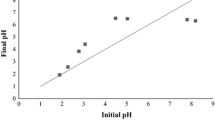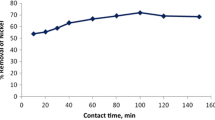Abstract
Chromium is one of the heavy metals that significantly affect water quality in Mongolia. The present study is focused on the remediation of surface water contaminated with chromium (III) by a permeable barrier in order to prevent sediment pollution. The adsorption capacity of the selected materials (13X zeolite and vermiculite) was investigated at different sorbent dosages, pH and initial Cr(III) concentration. The equilibrium adsorption studies showed that vermiculite has a higher Cr(III) removal efficiency in comparison with 13X zeolite. A fungal isolate obtained from the sediment samples collected near Tuul River (Mongolia) was selected from enriched Luria-Bertani medium, showing a good performance for Cr(III) removal (78.2% for an initial concentration of 50 mg/L). The fungal isolate was genetically typed by DNA sequencing and was identified as belonging to the Alternaria alternata species. 13X zeolite showed the best performance for Cr removal in the permeable barrier assays compared to vermiculite, achieving a total removal of 96% and a global uptake of 2.49 mg/g. After 13 days of operation none of the barriers reached saturation with chromium.






Similar content being viewed by others
References
Acevedo-Figueroa D, Jiménez BD, Rodríguez-Sierra CJ (2006) Trace metals in sediments of two estuarine lagoons from Puerto Rico. Environ Pollut 141:336–342. doi:10.1016/j.envpol.2005.08.037
Alexander CR, Smith RG, Calder FD, Schropp SJ, Windom HL (1993) The historical record of metal enrichment in two Florida estuaries. Estuaries 16:627–637. doi:10.2307/1352800
Batjargal T, Otgonjargal E, Baek K, Yang J-S (2010) Assessment of metals contamination of soils in Ulaanbaatar, Mongolia. J Hazard Mater 184:872–876. doi:10.1016/j.jhazmat.2010.08.106
Chen C-F, Ju Y-R, Chen C-W, Dong C-D (2016) Vertical profile, contamination assessment, and source apportionment of heavy metals in sediment cores of Kaohsiung Harbor, Taiwan. Chemosphere 165:67–79. doi:10.1016/j.chemosphere.2016.09.019
El-Bayaa AA, Badawy NA, AlKhalik EA (2009) Effect of ionic strength on the adsorption of copper and chromium ions by vermiculite pure clay mineral. J Hazard Mater 170:1204–1209. doi:10.1016/j.jhazmat.2009.05.100
Ferronato C, Silva B, Costa F, Tavares T (2016) Vermiculite bio-barriers for Cu and Zn remediation: an eco-friendly approach for freshwater and sediments protection. Int J Environ Sci Technol 13:1219–1228. doi:10.1007/s13762-016-0957-8
Henderson AD, Demond AH (2007) Long-term performance of zero-valent iron permeable reactive barriers: a critical review. Environ Eng Sci 24:401–423. doi:10.1089/ees.2006.0071
Islam MS, Ahmed MK, Raknuzzaman M et al (2015) Heavy metal pollution in surface water and sediment: A preliminary assessment of an urban river in a developing country. Ecol Indic 48:282–291. doi:10.1016/j.ecolind.2014.08.016
Li X, Shen Z, Wai OWH, Li Y-S (2001) Chemical forms of Pb, Zn and Cu in the sediment profiles of the Pearl River Estuary. Mar Pollut Bull 42:215–223. doi:10.1016/S0025-326X(00)00145-4
O’Hannesin SF, Gillham RW (1998) Long-term performance of an in situ “iron wall” for remediation of VOCs. Ground Water 36:164–170
Obiri-Nyarko F, Grajales-Mesa SJ, Malina G (2014) An overview of permeable reactive barriers for in situ sustainable groundwater remediation. Chemosphere 111:243–259. doi:10.1016/j.chemosphere.2014.03.112
Park J-B, Lee S-H, Lee J-W, Lee C-Y (2002) Lab scale experiments for permeable reactive barriers against contaminated groundwater with ammonium and heavy metals using clinoptilolite (01-29B). J Hazard Mater 95:65–79. doi:10.1016/S0304-3894(02)00007-9
Parsek MR, McFall SM, Chakrabarty AM (1995) Microbial degradation of toxic, environmental pollutants: Ecological and evolutionary considerations. Int Biodeterior Biodegrad 35:175–188. doi:10.1016/0964-8305(95)00032-Z
Rudnick RL, Gao S (2003) 3.01 - Composition of the Continental Crust A2 - Holland, Heinrich D. In: Turekian KKBT-T on G (ed). Pergamon, Oxford, pp 1–64
Salomons W, Förstner U (1984) Sediments and the Transport of Metals. In: Metals in the Hydrocycle. Springer, Berlin, pp 63–98
Silva B, Figueiredo H, Quintelas C, Neves IC, Tavares MT (2012) Improved biosorption for Cr(VI) reduction and removal by Arthrobacter viscosus using zeolite. Int Biodeterior Biodegrad 74:116–123. doi:10.1016/j.ibiod.2012.05.026
Silva B, Tuuguu E, Costa F et al (2016) Permeable biosorbent barrier for wastewater remediation. In: 2nd EWaS International Conference: “Efficient & Sustainable Water Systems Management toward Worth Living Development, 1–4 June 2016. Chania, Crete, Greece
Statham TM, Stark SC, Snape I, Stevens GW, Mumford KA (2016) A permeable reactive barrier (PRB) media sequence for the remediation of heavy metal and hydrocarbon contaminated water: a field assessment at Casey Station, Antarctica. Chemosphere 147:368–375. doi:10.1016/j.chemosphere.2015.12.133
USEPA (2007) Microwave assisted acid digestion of sediments, sludges, soils, and oils, 3051. Environmental Protection Agency, United States of America
Vignola R, Bagatin R, De Folly D’AA et al (2011) Zeolites in a permeable reactive barrier (PRB): one year of field experience in a refinery groundwater—Part 1: The performances. Chem Eng J 178:204–209. doi:10.1016/j.cej.2011.10.050
Wantanaphong J, Mooney SJ, Bailey EH (2005) Natural and waste materials as metal sorbents in permeable reactive barriers (PRBs). Environ Chem Lett 3:19–23. doi:10.1007/s10311-005-0106-y
Yener J, Kopac T, Dogu G, Dogu T (2006) Adsorption of basic yellow 28 from aqueous solutions with clinoptilolite and amberlite. J Colloid Interface Sci 294:255–264. doi:10.1016/j.jcis.2005.07.040
Zhang J, Liu CL (2002) Riverine composition and estuarine geochemistry of particulate metals in China—weathering features, anthropogenic impact and chemical fluxes. Estuar Coast Shelf Sci 54:1051–1070. doi:10.1006/ecss.2001.0879
Zhu X, Shan B, Tang W (2016) Heavy metal in sediments of Ziya River in northern China: distribution, potential risks, and source apportionment. Environ Sci Pollut Res:1–11. doi:10.1007/s11356-016-7561-9
Acknowledgements
A previous version of the paper has been presented in the 2nd EWaS International Conference: “Efficient & Sustainable Water Systems Management toward Worth Living Development”, Chania, Crete, Greece, 1-4 June 2016. This study was supported by the Portuguese Foundation for Science and Technology (FCT) under the scope of the strategic funding of UID/BIO/04469/2013 unit and COMPETE 2020 (POCI-01-0145-FEDER-006684) and BioTecNorte operation (NORTE-01-0145-FEDER-000004) funded by the European Regional Development Fund under the scope of Norte2020 - Programa Operacional Regional do Norte. Bruna Silva is thankful to the FCT for the concession of a Post-Doc grant (SFRH/BPD/112354/2015). Sampling process was supported by the collaborative research grant of National Academy of Sciences of Taiwan and Science and Technology Foundation of Mongolia, project code NCS-NECS2013003 and co-funded by the Young Scientist Grant (SEAS-2015075) of National University of Mongolia. E. Tuuguu would like to acknowledge the Erasmus-Mundus AREAS+ program for the opportunity to conduct research at CEB-University of Minho.
Author information
Authors and Affiliations
Corresponding author
Ethics declarations
Conflict of Interest
The authors declare that they have no conflict of interest.
Rights and permissions
About this article
Cite this article
Silva, B., Tuuguu, E., Costa, F. et al. Permeable Biosorbent Barrier for Wastewater Remediation. Environ. Process. 4 (Suppl 1), 195–206 (2017). https://doi.org/10.1007/s40710-017-0220-4
Received:
Accepted:
Published:
Issue Date:
DOI: https://doi.org/10.1007/s40710-017-0220-4




